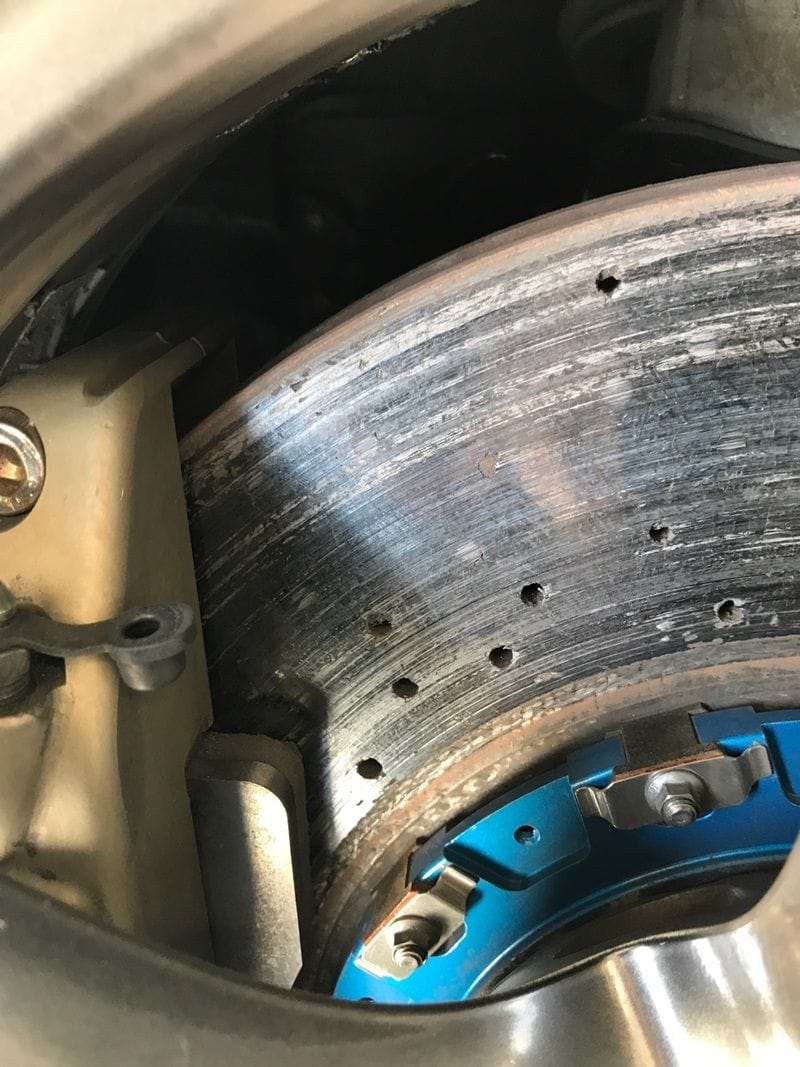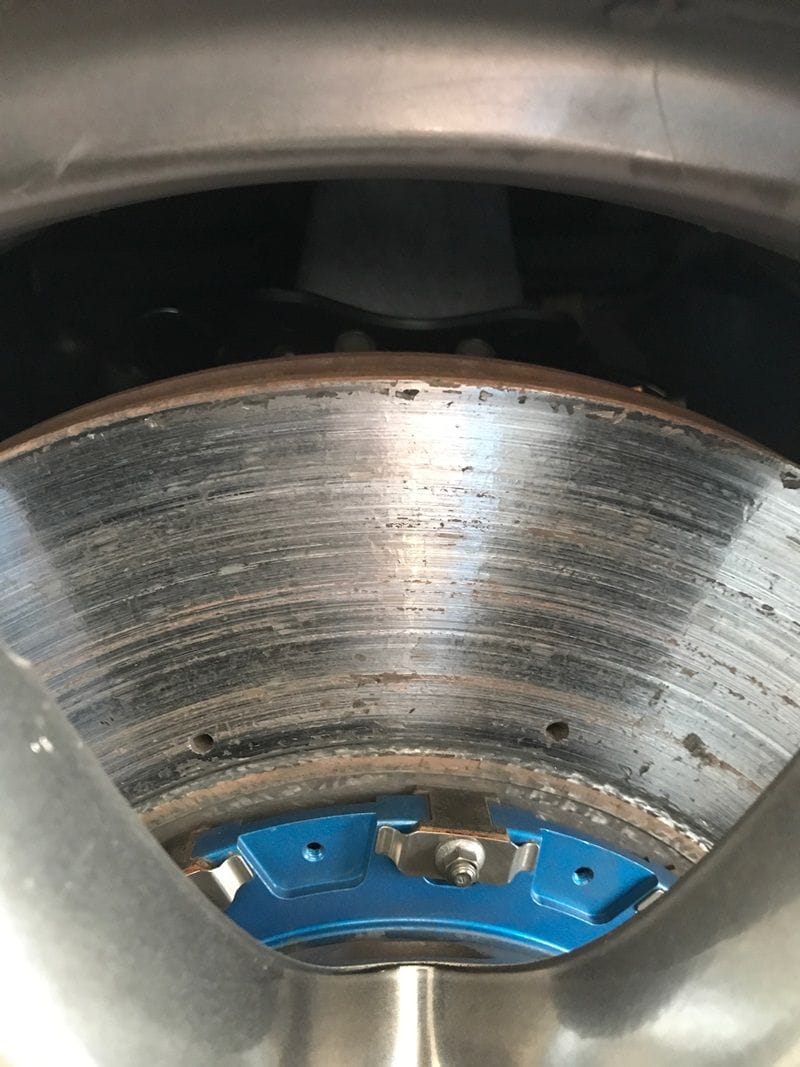You are browsing camaro5 

 |
|
|
#15 | |
 Drives: 2015 Z28, C7 Corvette, Evo X Join Date: Jul 2013
Location: Irvine
Posts: 211
|
Quote:
OE is made by mass production, so the body is "Cast" one piece, while RacingBrake calipers are "Forged" aluminum alloy with two halves assembled together with 12.9 grade alloy steel bolt. Stiffer & more rigid calipers can deliver a stronger and more consistent brake torque than less rigid body (OE) which means higher braking efficiency and also can eliminate pad taper wear and extend pad life. Average track driver may not feel the difference, but the discriminating and competing drivers would. |
|
|
|

|
|
|
#16 |
 Drives: 2015 Z28, C7 Corvette, Evo X Join Date: Jul 2013
Location: Irvine
Posts: 211
|
The Racing Brake Sintered Metallic pads will work with OEM Brembo Calipers. We actually used the pads first with the OE calipers and there was a noticeable difference compared to stock pad. It felt like a 50% increase in braking power. We made the switch to the Racing Brake Caliper for a stronger and more consistent brake torque than less rigid body (OE) which means higher braking efficiency and also can eliminate pad taper wear and extend pad life. The metallic pads also are claimed to enhance the life of the Carbon Ceramic Rotor. I have seen this already after two track events where the fracturing is now "cured" and the rotor is smooth from the deposits of the metallic pad.
|
|
|

|
|
|
#17 |
|
Drives: Camaro Justice Join Date: Jun 2007
Location: Virginia
Posts: 20,174
|
Brembo spends more money on R&D annually than all other brake companies combined. Their testing facilities are amazing. The only thing I have seen that is similar is at Roush Engineering. In development of the Z/28, the CC rotors with OE calipers generated so much braking force, they were spinning the tires on the wheels. The only complaints about the factory Z/28 package have been curb weight and RWHP.
Searching for a better pad, I get it. Searching for a better caliper... every racer wants every advantage they can find so why not. |
|
|

|
|
|
#18 | |
 Drives: 2015 Z28, C7 Corvette, Evo X Join Date: Jul 2013
Location: Irvine
Posts: 211
|
 Quote:
|
|
|
|

|
|
|
#19 |
 Drives: Camaro Join Date: Apr 2010
Location: Fullerton, CA
Posts: 78
|
More up-to-date testimonial from GTR community.
http://www.gtrheritage.com/topic/671...ke#entry124001 A revolutionary sintered brake pad developed by RacingBrake. Not only it can deliver a very high COF (0.65) with consistent brake torque under higher temperature (than irons) when run CCM brakes, but it can actually heal and restore the damaged CCM discs. Rotor surface condition (pitted due to heat stress and carbon oxidation) prior to sintered pad was deployed.  After use (street and track) with transfer of layer from brake pads.   These are not magic show, it's a proven result with 16 month of development and countless track and street tests on ZR1, GTR and Z28. Discussion on GTR forum. http://www.gtrheritage.com/topic/671...cmcarbon-pads/ http://www.gtrheritage.com/topic/635...ke#entry113545 |
|
|

|
|
|
#20 |
  Drives: 15 Z28, 01 Corvette, 96 Corvette Join Date: Dec 2016
Location: Colorado
Posts: 863
|
Im really interested in this but I am scared to try anything other then factory. I cannot afford to do this stuff twice. its all I can do to afford to keep tires under this car. It to the point that I am looking at buying other light cars that do not cost $1,000 a day to track.
How long do these pads last compared to stock when run on stock rotors? What are these pads costing? How certain is everyone that these pads help rotor life? Honestly, I don't care if they stop better. I have to reduce the cost of driving this car. I am fine with something stopping less. I got this car cause I thought it would be less then repairing my old vette all the time. Its not... I can put a new LS1 in every year for what this car cost in consumables.
__________________
2018 Sierra RCSB | 2015 Z28 Camaro | 1989 B2200 with a 327 | 1996 LT4 Z51 Corvette | 1973 427 Nova
|
|
|

|
|
|
#21 | |
 Drives: 2012 BMW 135i Join Date: Nov 2016
Location: MD
Posts: 396
|
Quote:
1) is it ok to switch to the sintered pad once the rotors become ruff and are starting to increase brake pad wear or is that too late? 2) what type of wear rates are you seeing for this pad? Does it wear the same or half as much as a stock pad? 3) any data you can share on how many pad changes you get to a set of these rotors or how many times you've changed pads on a set of rotors? Thanks! |
|
|
|

|
|
|
#22 | |
 Drives: Camaro Join Date: Apr 2010
Location: Fullerton, CA
Posts: 78
|
Answer to the question from a Porsche owner in rennlilst forum might be helpful here.
Quote:
To achieve a healthy braking operation it's necessary to transfer a layer from the pad surface on to the rotor face. For iron rotors (with semi-metallic pads) this usually can be achieved with careful selection of iron rotor material and brake pad compound. However since the CCM rotors brake is running at a higher (~30%) temperature level than iron so using conventional semi-metallic pad becomes challenging due to the temperature limit of resin that holds the friction ingredient together. Resin is of plastic nature so when the pad is heated up it becomes soft and starts losing its binding strength, that's when you feel brake fade and notice resin emitted to rotor surface with uneven/un-unifor layers (bad deposit) that will cause vibration and other ill effect. Sintered pad on the other hand, uses no resin, and is of full (100%) metallic, it's composed of various metallic powder. Those powder were compressed together under extremely high pressure, under very high temperature, takes days to cure and form together with the steel backing plate which is made of high tensile strength alloy steel so they for more resistant to deformation (warping) under repeated heat cycles. During bed-in process the sintered pad starts transferring a very "uniform" layers (good deposit) over to rotor surface which also forming a protective coat on rotor surface, from thereon the friction is taken place between the deposit layers between the pad and rotor surface. If a CCM rotor is already damaged (pitted-rough surface) due to the heat stress & incompatible pads, after bedding in with sintered pad, those surface will begin to heal, and eventually the metallic layer will smooth out the entire disc surface (including drill holes), we used dial gauge to check run out on those healed surface and the run out is within the tolerance of .00013" During this rotor surface healing (patching) process you will notice the pad will wear out faster than normal, but after the rotor surface is restored not only the rotor life is to be prolonged, but the pad wear rate will become normal. |
|
|
|

|
|
|
#23 | |
 Drives: Camaro Join Date: Apr 2010
Location: Fullerton, CA
Posts: 78
|
Quote:
2 & 3. See below Below is a review on RB sintered pads posted on GTR forum: http://www.gtrheritage.com/topic/635.../?hl=+sintered ---------------------------------------------------------------- Warren-RB, on 08 Jul 2016 - 4:41 PM, said:  When it comes to evaluating a brake pad, I think following criteria are what most of us are looking for:--------------------------------------------------------------------------------werks, on 08 Jul 2016 - 6:54 PM, said:Yep guys I've been testing these including hammering on them at a private test day at Thunderhil on the 5 mile track where the tack was just open all day with no run groups. That day alone I put over 50 gallons of fuel through the car beating on them and I can say that the pads worked flawlessly! Warren touched on some of the key points of the new pad material but they are:
|
|
|
|

|
|
|
#24 | |
|
Raging Bull Reborn
Drives: '09 CGM Z063LZ '15 RH Z/28 #0631 Join Date: Mar 2012
Location: Broken Arrow OK
Posts: 765
|
Quote:
__________________
 Toy 1 '15 RH Z/28 w/AC & Radio S/N 0631 Toy 2 '09 CGM Z06 3LZ My DD: '17 Ford Mustang GT Her DD: '14 F150 Ecoboost 3.5 |
|
|
|

|
|
|
#25 | |
 Drives: 2015 Z28, C7 Corvette, Evo X Join Date: Jul 2013
Location: Irvine
Posts: 211
|
Quote:
I ran my OEM Rotors that came with the car for a full year of competition and then recently switched to the sintered pad and it has essentially resurfaced the CCR from all the fracturing that was caused. 2) what type of wear rates are you seeing for this pad? Does it wear the same or half as much as a stock pad? Wear rates are about the same as OEM pads 3 or so weekends is what I usually get and that is with time trial and race with NASA ST2 and TT2 3) any data you can share on how many pad changes you get to a set of these rotors or how many times you've changed pads on a set of rotors? I am on my second set of Racing Brake Pads and still on my first set of OEM CCR. |
|
|
|

|
|
|
#26 |
 Drives: 2015 Z28, C7 Corvette, Evo X Join Date: Jul 2013
Location: Irvine
Posts: 211
|
If you can get a dealer to cover brake pads or brake rotors please send me their contact info. I've never heard of that being an available offering.
|
|
|

|
|
|
#27 |
|
Jumanji
Drives: '14 Z/28 - AGM - No A/C Join Date: Mar 2014
Location: Alaska
Posts: 1,688
|
A few thoughts that I have after reading everything posted. Essentially, the CCM rotors gain a layer of sintered (fine metal particals) material, which forms a new braking surface? Your CCMs almost become the reverse of say the BWM M4 ceramic faced rotors?
At what point does the material stop transferring, and begin to wear? Will the cycle repeat itself, as in repair, wear, repair, never wearing into the CCMs? I would guess that the CCM would still be affected by heat transfer and susceptible to baking off the bonding material holding the carbon fibers together.
__________________
Keeper of the 5th Gen Z/28 Registry.
Registry Facebook. Follow: @5th_gen_z28_registry I track wrecked Z/28s Total lost -41 |
|
|

|
|
|
#28 | |
 Drives: 2015 Z28, C7 Corvette, Evo X Join Date: Jul 2013
Location: Irvine
Posts: 211
|
Quote:
|
|
|
|

|
|
|
|
|
 |
|
|